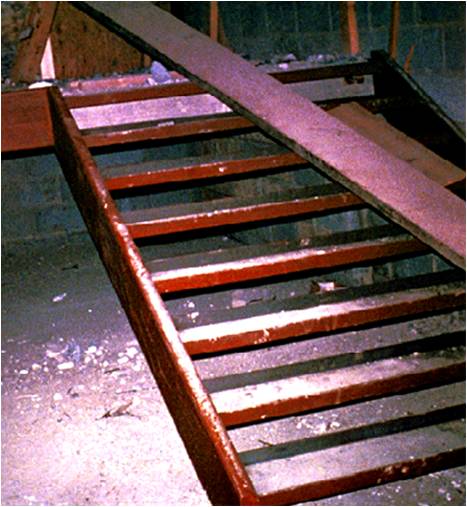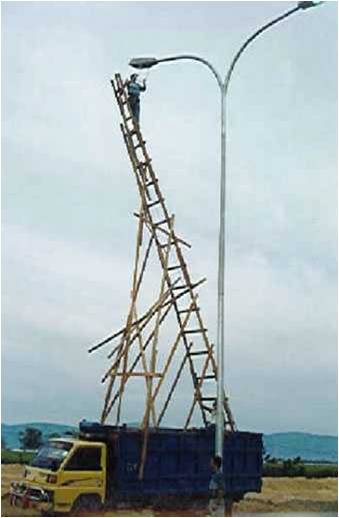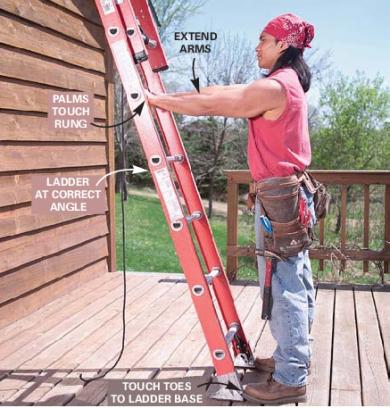3.3 Construction Safety Standards - Stairways And Ladders Quiz

This test is designed to test employee knowledge of construction safety,usage of Ladders and stairways, and their installation.
- 1.
Are metal ladders allowed on Kiewit job sites?
- A.
Yes
- B.
No
Correct Answer
B. NoExplanation
Metal ladders are not allowed on Kiewit job sites.Rate this question:
-
- 2.
A break in elevation of _____ or more requires a step or ladder for access?
- A.
7 ¾ in
- B.
18 in
- C.
12 in
- D.
16 in
Correct Answer
B. 18 inExplanation
A break in elevation of 18 inches or more requires a step or ladder for access because it is considered a significant change in height that may pose a risk to individuals trying to climb or descend without assistance. Steps or ladders provide a stable and secure means of accessing areas with significant elevation changes, ensuring safety and preventing accidents.Rate this question:
-
- 3.
How much force are handrails required to withstand?
- A.
At least 1000lbs
- B.
At least 200lbs
- C.
At least 500lbs
- D.
No more than 100
Correct Answer
B. At least 200lbsExplanation
Handrails are required to withstand at least 200lbs of force. This is because handrails are designed to provide support and stability for individuals using stairs or ramps. They need to be able to withstand a certain amount of force to ensure the safety of those relying on them for balance and support. Therefore, a minimum requirement of 200lbs is necessary to ensure that handrails can effectively serve their purpose.Rate this question:
-
- 4.
When are handrails required?
- A.
Stairs with 4 or more risers
- B.
Stairs higher than 30 inches
- C.
Stairs less than 44 in wide
- D.
All of the Above
Correct Answer
D. All of the AboveExplanation
Handrails are required in all of the mentioned scenarios. Handrails are necessary for stairs with 4 or more risers to provide support and stability while ascending or descending. Similarly, handrails are required for stairs higher than 30 inches to ensure safety and prevent falls. Additionally, handrails are also necessary for stairs less than 44 inches wide to provide a gripping surface for users. Therefore, in all these situations, handrails are required to meet safety standards and regulations.Rate this question:
-
- 5.
How big of a platform is needed outside a door?This isn't acceptable.
- A.
20 inches
- B.
20 inches past door swing
- C.
The width of door swing
- D.
None is needed
Correct Answer
B. 20 inches past door swingExplanation
The correct answer is "20 inches past door swing". This means that a platform of 20 inches is needed beyond the area where the door swings open. This is necessary to ensure that there is enough space for someone to comfortably stand or maneuver outside the door without obstruction.Rate this question:
-
- 6.
Do metal pan stairways need a temporary filler to be able to use prior to concrete installation?
- A.
Yes
- B.
No
Correct Answer
A. YesExplanation
Metal pan stairways typically require a temporary filler before concrete installation. This is because the metal pans, which serve as the formwork for the concrete, need to be supported and stabilized during the pouring and curing process. Temporary fillers, such as foam or plywood, are used to provide this support and prevent the pans from shifting or deforming under the weight of the concrete. Without a temporary filler, the metal pans may not be able to withstand the pressure and could result in an uneven or unstable stairway.Rate this question:
-
- 7.
Can a job built ladder have a varying distance between steps?
- A.
Yes
- B.
No
Correct Answer
B. NoExplanation
A job built ladder is constructed for specific purposes and safety regulations. It is important for the ladder to have a consistent and uniform distance between steps to ensure stability and safety for the user. Varying distances between steps could lead to instability, making it unsafe for individuals to climb or descend the ladder. Therefore, a job built ladder should not have a varying distance between steps.Rate this question:
-
- 8.
How much weight must a self supporting ladder be able to withstand?
- A.
2 times the intended load
- B.
4 times the intended load
- C.
The amount of the intended load
- D.
"a little less is fine, they are over designed."
Correct Answer
B. 4 times the intended loadExplanation
A self-supporting ladder must be able to withstand 4 times the intended load. This is because the ladder needs to be able to support the weight of the person using it, as well as any additional weight or force that may be applied during use. By designing the ladder to withstand 4 times the intended load, it ensures that the ladder is strong and durable enough to handle various situations and potential accidents, providing a safe and reliable tool for the user.Rate this question:
-
- 9.
At what ratio or angle does a ladder need to be leaning to achieve optimal performance and safety for those who use it?
- A.
1 foot away for 4 feet of height 4:1
- B.
1 foot away for 2 feet of height 2:1
- C.
1 foot away for 8 feet of height 8:1
- D.
Straight up and down
Correct Answer
A. 1 foot away for 4 feet of height 4:1Explanation
The correct answer is "1 foot away for 4 feet of height 4:1". This ratio, also known as the 4-to-1 ratio, indicates that for every 4 feet of height, the ladder should be placed 1 foot away from the wall or surface it is leaning against. This angle provides optimal performance and safety because it ensures stability and prevents the ladder from tipping over. It allows for a proper balance between the weight of the person using the ladder and the force exerted on the ladder.Rate this question:
-
- 10.
How far must a ladder extend past the desired landing area?
- A.
1 Foot Above
- B.
1 Foot Below
- C.
Just to the height of landing
- D.
3 Feet above landing
Correct Answer
D. 3 Feet above landingExplanation
A ladder should extend at least 3 feet above the desired landing area for safety reasons. This allows the person using the ladder to have a secure handhold while climbing up or down, and also provides stability and prevents the ladder from tipping over. Having the ladder extend 3 feet above the landing ensures that the person can safely transition onto the landing without the risk of falling or losing balance.Rate this question:
-
Quiz Review Timeline +
Our quizzes are rigorously reviewed, monitored and continuously updated by our expert board to maintain accuracy, relevance, and timeliness.
-
Current Version
-
Mar 21, 2023Quiz Edited by
ProProfs Editorial Team -
Dec 22, 2008Quiz Created by
Kiewit
- Back Safety Quizzes
- Chemistry Safety Quizzes
- Drill Press Safety Quizzes
- Electrical Safety Quizzes
- Fire Safety Quizzes
- General Safety Quizzes
- Kitchen Safety Quizzes
- Laboratory Safety Quizzes
- Lathe Safety Quizzes
- Office Safety Quizzes
- Online Safety Quizzes
- Patient Safety Quizzes
- Radiation Safety Quizzes
- Safe Lifting Quizzes
- Sander Safety Quizzes
- Saw Safety Quizzes
- Shop Safety Quizzes
- Work Safety Quizzes
- Workplace Safety Quizzes







